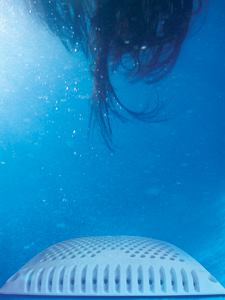LThe drain-cover standard cited in the Virginia Graeme Baker Pool and Spa Safety Act may undergo a third change.
In February, NSF International submitted a proposal to a standards-writing committee that would tighten the language in ASME/ANSI A112.19.8. The section in question describes how drain covers must be tested for the potential for hair entrapment.
NSF, an Ann Arbor, Mich.-based certification and standards writing agency, believes the current language leaves too much room for interpretation.
So far, changes to the standard have been made in the section regarding ultraviolet-light testing for the drains. The committee also is considering an addendum for drains in portable hot tubs.
NSF made the request after trying two testing methods on drain cover models. One version involved sweeping hair from side to side 3 inches in each direction from the initial location of the mannequin head to which it was attached.
Using the other method, testers distributed the hair over more of the drain’s suction surface by moving the hair 8 inches in each direction.
Both techniques complied with the standard, which doesn’t state how wide the sweeping motion should be. Yet the two methods yielded different results.
“Some of the standard is not specific enough in areas where varying your method just a little bit, while still complying with the standard, can get you a 200- or 300 percent difference in your approved flow rate,” said Sung Choe, technical manager in NSF’s Recreational Water Program. “It’s considerable.”
NSF would like to see both methods required in the standard. The smaller sweeping motion would serve as the best indicator of whether or not hair could be fed into the openings. The wider motion would test the whole surface of the drain.
The proposed language also would state that the fitting must be tested in several locations, including each corner, around the edges, and at the center of the fitting to allow for differing levels of force along the surface.
The committee is in the preliminary stages of reviewing the proposal.
“The committee is considering, but I think it’s a forgone conclusion that [NSF’s] suggestion is very much on target, and I don’t think there will be any difficulty in it,” Committee Chairman Leif Zars said.
Zars expects the process to take approximately eight months.
“In the meantime, we’re communicating with testing laboratories to ensure that they have a better understanding of what’s intended so that they conduct the test more in the spirit of what it was intended to do,” Zars said. “We want to make sure that we are replicating real-life happenings as closely as possible.”
